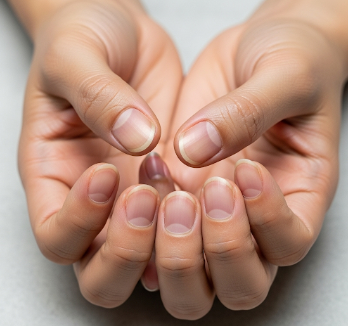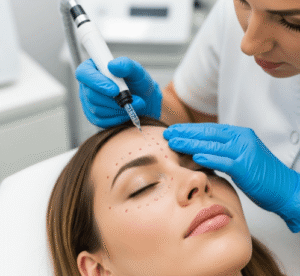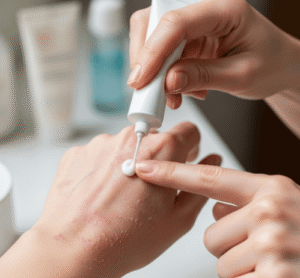Overview
Koilonychia, commonly known as spoon nails, is a nail disorder characterized by thin, concave, or spoon-shaped fingernails or toenails. The condition can be subtle initially but may progress to more pronounced deformities. Spoon nails can indicate underlying nutritional deficiencies, systemic conditions, or chronic trauma to the nails.
In Korea, dermatology and internal medicine clinics provide advanced diagnostics for koilonychia, including blood tests, nutritional assessments, and evaluation of systemic health. Early detection and treatment can correct nail changes and address the underlying health issues.
Key Facts
- ➔ Koilonychia presents as concave nails that curve upward at the edges, resembling a spoon.
- ➔ Often associated with iron deficiency anemia, but can also result from thyroid disease, liver disorders, or trauma.
- ➔ Can affect one or multiple nails, usually fingernails before toenails.
- ➔ Nail changes may occur gradually and are often painless initially.
- ➔ Treatment focuses on correcting nutritional deficiencies or underlying health conditions.
What is Koilonychia (Spoon Nails)?
Koilonychia refers to a morphological change of the nails, leading to a concave or scooped appearance:
- ➔ Appearance: Nails become thin and concave, sometimes with raised edges that can hold liquid.
- ➔ Progression: Mild cases may show slight cupping, while severe cases result in deep spooning.
- ➔ Causes: Can be congenital (present at birth) or acquired due to systemic health issues.
- ➔ Clinical significance: Spoon nails often serve as a visible indicator of underlying disorders, particularly iron deficiency or chronic illness.
Koilonychia may coexist with other nail abnormalities, such as brittle nails, ridges, or discoloration, further aiding diagnosis.
What Symptoms Are Related To
Koilonychia itself may not produce pain or discomfort, but related symptoms often indicate underlying conditions:
- ➔ Fatigue or weakness (commonly due to iron deficiency anemia)
- ➔ Pale skin or mucous membranes
- ➔ Brittle or ridged nails
- ➔ Hair thinning or hair loss in systemic deficiencies
- ➔ Shortness of breath or dizziness in anemia
- ➔ Swelling of the tongue or mouth sores
- ➔ Symptoms related to chronic illnesses, such as thyroid disorders or liver disease
Observation of nail changes in conjunction with these symptoms can guide clinicians in identifying systemic causes.
What Causes / Possible Causes
Several conditions and factors can lead to koilonychia:
- ➔ Iron deficiency anemia: The most common cause, reducing oxygen delivery and affecting nail matrix formation.
- ➔ Chronic illnesses: Liver disease, hypothyroidism, or diabetes may alter nail growth.
- ➔ Trauma: Repeated pressure or injury to the nails can induce spooning.
- ➔ Congenital causes: Rare genetic conditions may present with spoon-shaped nails from birth.
- ➔ Nutritional deficiencies: Zinc or protein deficiency can contribute to nail abnormalities.
- ➔ Occupational exposure: Prolonged exposure to chemicals, detergents, or water can worsen nail deformities.
Identifying the underlying cause is crucial to correct the condition and prevent recurrence.
When Should I See My Doctor
Seek medical attention if you notice:
- ➔ Nails becoming increasingly concave or brittle
- ➔ Fatigue, pallor, or other signs of anemia
- ➔ Other systemic symptoms such as hair loss, dizziness, or swelling
- ➔ Nail changes associated with chronic disease or infection
- ➔ Pain, redness, or inflammation around the nails
- ➔ Nail changes affecting daily activities or aesthetics
Early evaluation allows timely diagnosis and correction of nutritional or systemic deficiencies.
Care and Treatment
Treatment for koilonychia primarily focuses on addressing the underlying cause:
- ➔ Iron supplementation: Oral or intravenous iron for iron deficiency anemia.
- ➔ Dietary modifications: Increasing intake of iron-rich foods like red meat, spinach, lentils, and fortified cereals.
- ➔ Treatment of systemic disorders: Managing thyroid dysfunction, liver disease, or other chronic illnesses.
- ➔ Nail care: Keeping nails trimmed, moisturized, and protected from trauma.
- ➔ Avoiding irritants: Limiting exposure to harsh chemicals, detergents, and excessive water.
- ➔ Monitoring: Regular follow-up to assess improvement in nail shape and overall health.
With proper care and correction of deficiencies, nails may gradually regain normal shape, although severe cases may require longer recovery time.
Treatment Options in Korea
Korean dermatology and internal medicine clinics provide comprehensive care for koilonychia:
- ➔ Laboratory testing: Blood tests for iron, ferritin, vitamin B12, and thyroid function.
- ➔ Nutritional counseling: Personalized diet plans to correct deficiencies and support nail health.
- ➔ Medication therapy: Oral or intravenous iron, vitamin, or mineral supplementation as needed.
- ➔ Dermatology care: Nail care techniques, protective treatments, and guidance to prevent trauma.
- ➔ Multidisciplinary approach: Collaboration between dermatologists, hematologists, and nutritionists for optimal results.
- ➔ Advanced monitoring: Regular assessment to track nail regrowth and resolution of underlying conditions.
Leading hospitals such as Seoul National University Hospital, Asan Medical Center, and Samsung Medical Center offer state-of-the-art diagnostics and treatment plans, ensuring both systemic health improvement and cosmetic recovery of nails.
In Summary: Koilonychia (spoon nails) is a visible marker of underlying nutritional or systemic disorders, most commonly iron deficiency anemia. Early detection, targeted treatment, and expert care in Korea can correct nail deformities, address systemic conditions, and prevent recurrence.
- ➔ Key Takeaway: Spoon-shaped nails should prompt evaluation for nutritional deficiencies and chronic illnesses.
- ➔ Action Point: Consult a dermatologist or internal medicine specialist for assessment, treatment, and monitoring.













